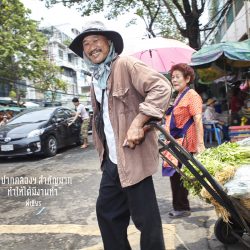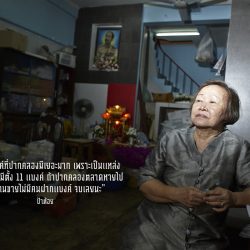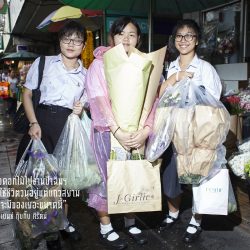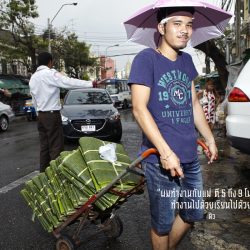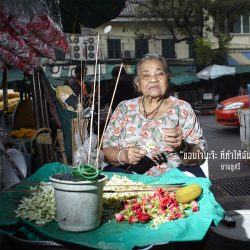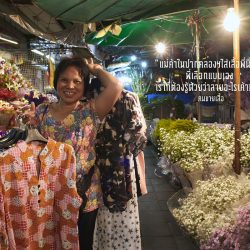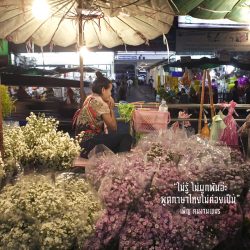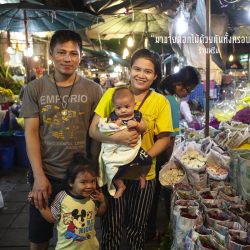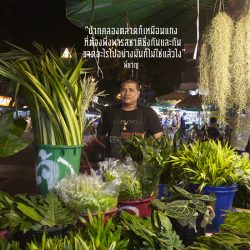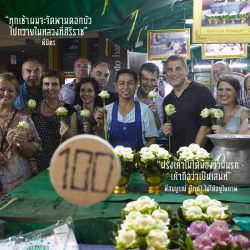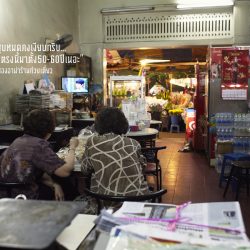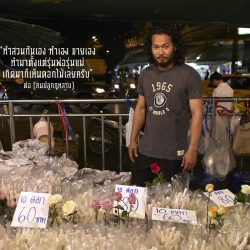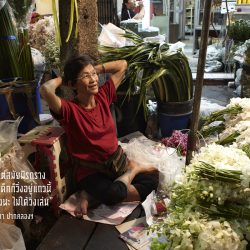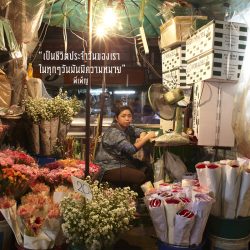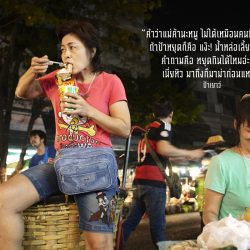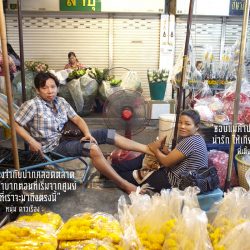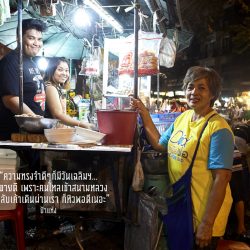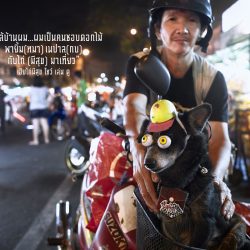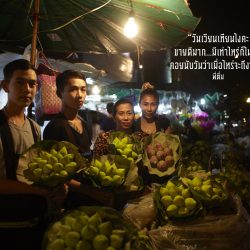THE PATTERNS OF RELATIONSHIPS BETWEEN THE PAK KLONG TALAT FLOWER MARKET COMMUNITY ARE CONNECTED BOTH PHYSICALLY, ECONOMICALLY AND SOCIALLY IN AN INTRIGUING HUMAN ECOSYSTEM.
While the current implementation of the government’s policies is intensely elevating the reorganization of traditional urban areas, the line between demolition, revitalization and development is, at times, being spread way too thin. Local “neighborhoods” and their qualitative characteristics are under great pressure following the authoritative desire to organize the city’s physical appearance as a part of the political agenda. Humans of Flower Market is a project that brought together a mobile photography exhibition and a publication, both of which were the results of the efforts by students from a Vernacular Architecture Conservation and Community Development course taught at Silpakorn University.

“I would like to keep things the same, and for things to return to be as they were.” – Uncle Sert
The students firstly observed, surveyed, documented and presented their findings related to the relationships between different members of the ‘Pak Klong Talat or Flower Market’ community, such as the flower merchants (both those with proper shops and street kiosks), the cart people, ice and food delivery people, city law enforcement agents, tuk tuk drivers, etc. Primary observations found that the patterns of relationships between the different groups were all connected both physically, economically and socially in an intriguing human ecosystem. An absence of one group or the other would therefore ignite a chain reaction cycle. Ultimately, the challenge in terms of the development of this long-standing flower market is how to maintain a balance between public space management for personal and public interests, while also supporting the neighborhood’s unique characteristics. The project’s open view towards an informal economy as an obstacle as well as an opportunity is just only a step in the right direction that will hopefully lead to asking the right questions, and finding the right answers.

“What is a garland made of? It is made of crown flowers and this change will affect the farming of crown flowers. If it is jasmine, it will affect jasmine farming, and there are also marigolds and roses. The ribbons are made by poor people in Ayutthaya after they finish farming the rice.” – Aunty Yao

“My son is studying to become a pilot at Rangsit University. The money I make selling orchids is used to support him.” – Aunty Tid

“I met my husband here, he sold cassette tapes at the front of the Empire Theatre.” – Thongsai Mualnugul
นโยบายของรัฐในปัจจุบันดูจะให้ความสําคัญกับความเป็นระเบียบเรียบร้อยของเมืองมากทีเดียว แต่ในขณะเดียวกัน เส้นแบ่งระหว่างการรื้อล้าง การฟื้นฟู และการพัฒนา ก็ดูจะเบาบางเสียเหลือเกิน “ความเป็นย่าน” ซึ่งมีคุณสมบัติเชิงคุณภาพกำลังเผชิญกับแรงกดดันจากการเจริญเติบโตทางเศรษฐกิจ ความต้องการจัดระเบียบกายภาพ และนโยบายทาง การเมืองของผู้มีอํานาจ… โครงการ Humans of Flower Market หรือมนุษย์ปากคลองฯ น้ี ประกอบด้วยหนังสือรวมภาพถ่าย และนิทรรศการภาพถ่ายเคลื่อนท่ี (จัดขึ้นระหว่าง 6-15 พฤษภาคม 2559 ที่ท่าเรือยอดพิมาน) โดยเป็นส่วนหนึ่งของผลงานนักศึกษาระดับปริญญาโท-เอก รายวิชาการอนุรักษ์สถาปัตยกรรมพื้นถิ่นและการพัฒนาชุมชน หลักสูตรสถาปัตยกรรมพื้นถิ่น คณะสถาปัตยกรรมศาสตร์ มหาวิทยาลัยศิลปากร จุดประสงค์เพื่อสังเกต สำรวจ บันทึก และนำเสนอลักษณะความสัมพันธ์ของกลุ่มผู้คนที่แตกต่างหลากหลาย ในพื้นที่โดยรอบของย่าน “ปากคลองตลาด” รวมถึงความคิดเห็นท่ีพวกเขามีต่อ “ความเป็นย่านของปากคลองตลาด” ที่ย่อมมีการเปลี่ยนแปลงอย่างหลีกเลี่ยงไม่ได้จากการเจริญเติบโตของเมืองและนโยบายจากภาครัฐ จากการสังเกตในเบื้องต้น พบรูปแบบความสัมพันธ์และกลุ่มคนหลากหลาย เช่น มนุษย์ดอกไม้ (ทั้งที่ขายในตึกแถวและแผงลอย) รวมถงึ มนุษย์รถเข็น มนุษย์โยนของ มนุษย์ส่งน้ําาแข็ง มนุษย์อาหารตามสั่ง มนุษย์นวดมนุษย์ เทศกิจ มนุษย์ตุ๊กตุ๊ก ฯลฯ เหล่านี้ล้วนมีความสัมพันธ์กันทั้งในเชิงกายภาพ เศรษฐกิจ และ สังคม เป็นระบบนิเวศน์เชิงมนุษย์ที่น่าสนใจ การมีอยู่หรือหายไปของกลุ่มใดกลุ่มหน่ึงย่อมส่งผลต่อกัน ท้ายที่สุดความท้าทายของการพัฒนาพื้นที่ปากคลองตลาดคงขึ้นอยู่กับการสร้างสมดุลระหว่างการจัดการการใช้สอยพื้นที่สาธารณะเพื่อความเป็นสาธารณะหรือประโยชน์ส่วนตัว ความเป็นระเบียบเรียบร้อย และความเป็นย่าน การมอง informal economy เป็นอุปสรรคหรือโอกาสในการพัฒนาเมือง โครงการนี้เป็นเพียงบทเริ่มต้นของการทำหน้าที่เป็น platform ท่ีรวบรวมความคิดเห็นและมุมมองต่างๆ ของผู้คนในพื้นท่ี เพื่อสร้างพื้นท่ี เพื่อการรับฟังและเเลกเปลี่ยนความคิดเห็นซึ่งน่าจะนําาไปสู่การต้ังคําถามและหาทางออกอย่างสร้างสรรค์ต่อไป
TEXT: SUPITCHA TOVIVICH
PHOTO: SASAMON RATTANALANGKARN
facebook.com/ManusPakkhlong


